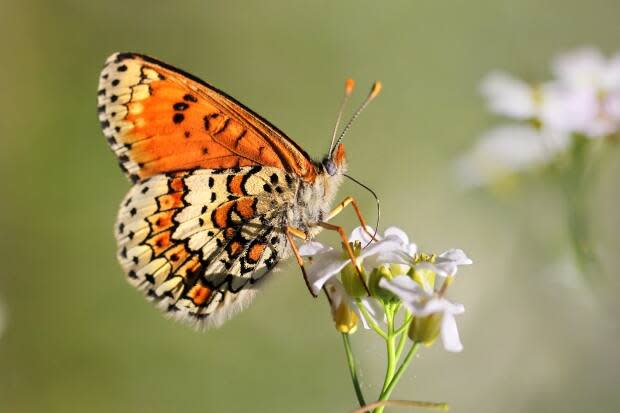Butterflies containing not one, but two parasitic wasps, surviving after release on Finnish island

An ecologist nwho introduced the orange and brown Glanville fritillary butterfly to a tiny island near Finland thirty years ago, to study how the population would spread, didn't know he was also introducing some surprise stowaways — two kinds of parasitic wasps, one that lives inside the other.
Evolutionary biologist Anne Duplouy, who has been tracking all three, says it's an example of the level of caution scientists must use be in introducing species to an ecosystem. But she's also surprised at how well all three species have survived decades on.
"There is always the potential for introducing a parasitoid, a parasite, like we have experienced in our system," she told As It Happens host Carol Off.
Duploy described the relationship between the butterfly and the two wasps as a series of nesting Russian dolls. Inside the butterfly caterpillar is the larvae of a parastic wasp, Hyposoter horticola, and inside that larvae is the larvae of another wasp, the hyperparastic Mesochorus cf. stigmaticus.
"Small [insects] actually lay their eggs within other insects," Duplouy said. "The larvae emerge from the eggs inside the body of the butterfly ... and then eat them from inside out."
"So it's a little bit gross, but it's very fascinating as well," she said.
Ecologist Ilkka Hanski brought the Glanville fritillary over to Sottunga, in the Åland archipelago in the Baltic Sea, from a neighbouring island in 1991. He was looking at the butterfly to test his theory of metapopulation, looking at how species cope with habitat loss.
Hanski's work is foundational to understanding how biodiversity is sustained in an ecosystem.

"Professor Hanski chose this particular island ... because he knew somehow the butterfly wouldn't be able to disperse," Duplouy said.
"It is not a very good flyer and the island is separated from any other island by at least six kilometres of water all around."
But Hanski didn't expect to see the tiny — and rare — wasps that sometimes burst from caterpillars, killing them before they can even become butterflies.
"That was kind of a surprise, after a few years," according to Duplouy.
Back then, not much was known about the parasitic wasp and the smaller hyperparasitoid wasp living inside of it. Recent studies show that the hyperparasitoid can kill the parasitic wasp around the same time as the larger wasp kills the caterpillar. Then, after ten days, the smaller wasp rises from the caterpillar's carcass.
Duplouy was surprised to see the three species (as well as bacteria carried by female parasitic wasps) still surviving on the island, thirty years later.
She published a study in the journal Molecular Ecology in July after tracking the butterflies and their wasps for a few years.
She says overall all three species had big enough numbers to be "a good population" but in the years when it didn't rain as much, or when there was a drought on the island, the butterfly population crashed. And because the wasps didn't have any other butterfly host, they couldn't parasitize anything else, and their population also crashed.
Her study looked at the genetics of the parasitic wasp, which were surprisingly diverse, even with those crashes.
"This butterfly somehow seems to recover from isolated population crashes, and the genetic diversity in Åland is still impressively high, despite all the bottlenecks the butterfly has been through," she told The Guardian.
But Duplouy is still cautious about the unintended effects of Hanski's initial study.
"We never introduce one species," she warned, "And in the case of arthropods, insects, spiders — crawlers everywhere — those bacteria can also have a very big impact on the population dynamic and persistence and resilience of those species in the habitat where we introduce them."
Written by Mehek Mazhar. Interview with Anne Duplouy produced by Chris Harbord.

